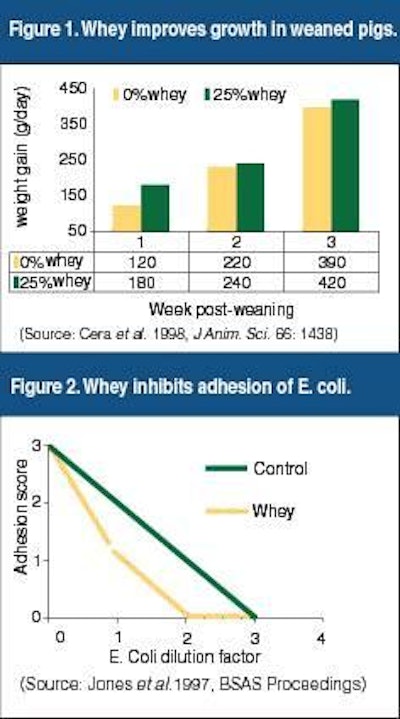
Whey is hardly a new ingredient, yet its beneficial effects in diets for piglets are not well understood, especially in Europe. A review of the state of knowledge on the subject is long overdue, but here are a few remarks which may help you make your own judgements.
Pioneer work conducted in Europe and the United States has clearly demonstrated that piglet diets based on cereals and soybean-derived ingredients support greater growth performance when supplemented with milk products such as dried whey. In most of these experiments and in accord with commercial experience, including up to 30% dried whey in simple diets consistently improved growth performance by as much as 50% in pigs weaned around 3 weeks of age. Naturally, the effects were more pronounced in the period immediately after weaning. More recently, it has been demonstrated that spray-dried whey may inhibit binding of pathogenic E. coli to intestinal mucosal surface and thus prevent infection .
The effectiveness of whey (and of dairy products in general) in improving piglet performance was attributed at first to increased palatability and protein digestibility. It is now clear, however, that it is the lactose and not the protein fraction of whey that is responsible for improved feed intake and weight gain during the first weeks post-weaning. In US trials conducted at The Ohio State University, lactose supplementation restored growth performance in diets devoid of dried whey, whereas lactalbumin supplementation failed to improve performance. Today, it is also well established that lactose has a laxative effect in piglets, causing piglets to produce soft stools. Nevertheless, this looseness is not associated with reduced animal performance; a fact well known since 1949.
But if the effectiveness of whey is not fully appreciated, the effects of its variable quality are even less understood. It is no secret that no two lots of whey are ever the same, as quality varies not only from source to source, but even within batches from the same cheese factory. As early as the 1950s, the research community was aware that roller-dried whey was inferior to spray-dried whey, and that ‘browned' or over-processed whey was generally of inferior quality.
So, what makes a source of whey most suitable for high-quality piglet feed? Here is a short list of points you can check.
Chemical analysis: Although it has been repeatedly demonstrated that chemical analysis is a very weak indicator of whey quality as far as piglet performance is concerned, adhering to certain specifications allows at least for some stability in formulation.
Note that sulphur and sodium are highly undesirable components in whey as they are linked to secretory diarrhoea. Actual research on piglets is limited, but German researchers investigated the effect of a high sulphate concentration in 29 samples of whey on faecal consistency in pre-ruminant calves. Sulphur content in whey ranged from 0.03% to 4.3% per kilogram drymatter. As expected, a high concentration of sulphate resulted in marked increases in incidents of diarrhoea. Extrapolating these data could lead us to adopt a safe level of sulphate in complete piglet diets of below 0.25% on an as-fed basis.
Sweet versus acid whey: Again this is an area where research is scant, although commercial experience indicates that high-quality sweet whey is invariably superior to acid whey of similar specifications. This observation is backed by our own investigations, in which sweet whey outperformed acid whey by about 10% during the first week post-weaning. In my opinion, this is due to the combined effects of increased palatability and reduced mineral content in sweet whey.
Colour: High-quality whey should have an off-white creamy colour. Certain batches may be more yellow, due to processing and (or) high levels of carotene in milk. Nevertheless, a brownish colour (see photo) is always indicative of excessive thermal processing and formation of Maillard reaction compounds, which diminish the nutritive value of whey and may also affect its palatability. Therefore, spray-dried whey is considered of superior quality compared to other processing methods.
Taste: A high-quality whey should have a pleasant taste (of course, sweet whey more so than acid whey). Quite often, low-quality/cheap sources of whey can be easily spotted from their revolting taste. This is a very empirical test requiring nothing more than a brave subject, but it is quite effective when used as part of an overall quality control programme!
Solubility: Whey should dissolve easily in warm water, leaving no foreign residue. Difficulty in dissolving indicates over-processing, whereas foreign matter indicates adulteration.
Flowability: Quite often, it is easy to identify the lowest-quality whey by asking plant personnel which whey flows better. This reflects the extra process step added by some whey suppliers to improve the handling capacities of whey, which is highly hygroscopic. Although not all high-fluidity whey products are of low quality, certain procedures used to improve fluidity may adversely affect quality. For example, granulation (pelleting) may denature whey proteins during thermal processing, whereas certain liquid flow agents may reduce palatability.
Ultimately, the best index for whey quality is the animal itself. Try to conduct a growth test before deciding to switch suppliers. Take extra care that the experimental diets are balanced for protein (amino acids), lactose and sodiumeach of these being quite variable among sources of whey.



.jpg?auto=format%2Ccompress&fit=crop&h=167&q=70&w=250)













